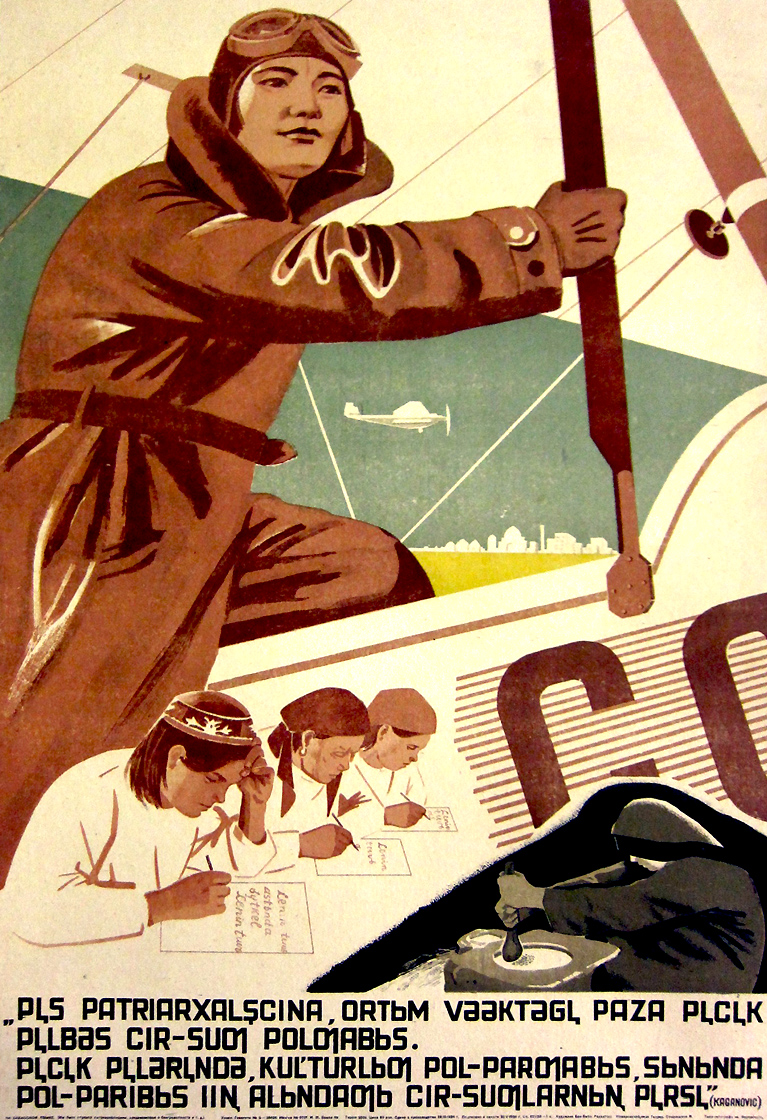
"We were a patriarchal country, Medieval and Illiterate..." --Lazar Kaganovich [Partial translation]
Poster Number: PP 860
Category: Education & Literacy
Poster Notes: Poster is aimed at a population in the southwestern section of East Siberia living in the Khakass Autonomous Region; Quote on poster is from Lazar Kaganovich (1893-1991), Chairman of the Party Control Commission.
Media Size: Please inquire
Poster Type: Lithograph
Publishing Date: c.1934
Editorial Information: Editor Nemipovskii; Technical Editor Spiriushkov.
Technical Information on Poster: IzoGiz No. 6707; I. 31. Order No. __; Submitted to production March 23, 1934; Approved for printing May 20, 1934; Size 62x88; 1 sheet; Price 60 kopeks.
Print Run: 2,000
Glavlit Directory Number: B-36424
Catalog Notes: PP 860 Education & Literacy
Language: Kakhass
Artist: Bri-Bein, Maria Feliksova — Бри-Бейн, Мария Феликсовна
Maria Feliksovna Bri-Bein was a Soviet graphic artist. Between 1910 and 1915, Bri-Bein received her artistic training at the Odessa College of Art under the tutelage of Kiriak Kostandi, a noted Ukrainian painter and an art scholar. In 1924, Bri-Bein continued her arts training in Moscow under the supervision of Ilya Mashkov, the noted Russian painter of still life and portraiture. From 1917 to 1919, Maria Bri-Bein was a member of TIURKH (Association of Southern Russian Artists) and she was ...
Read More About This Artist
Printer: Typolithography Workshop named for V.V. Vorovskii, Moscow — Типо-литография им. Воровского, Москва
The Typolithography Workshop named for V.V. Vorovskii was named in honor of Vatslav Vatslavovich Vorovskii (1871-1923) who was the head of Gosizdat (State Publishing House) from 1919 to 1920. After leaving Gosizdat, Vorovskii served as a diplomat for the Soviet Union. In 1923, he was assassinated in Lausanne, Switzerland. The printing house bearing his name was located in Moscow at 18 Dzerzhinskii Street, a thoroughfare that later was named Bolshaia Lubianka.
Read More About This Printer
Publisher: IzoGiz (State Publishing House of Fine Art) — Изогиз (Государственное издательство изобразительного искусства)
The history of IzoGiz begins with the formation of Ogiz, the Association of the State Book and Magazine Publishers. In 1930, the Sovnarkom of the Russian Socialist Federative Soviet Republic established Ogiz to centralize publishing under a monopoly in order to eliminate duplication of printed material, to streamline and control publishing production and its output, and to create a base for marketing books, training and technical manuals. In 1931, the Central Committee of the USSR ordered certain ...
Read More About This Publisher